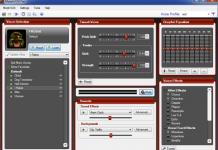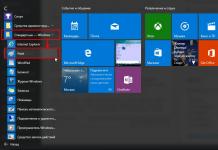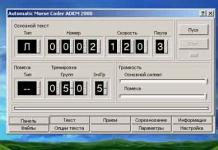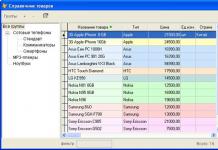You may not realize it, but your desktop computer probably uses a lot of power. This also means that it is responsible for increasing your electricity bill.
However, many people have a habit of leaving their PC turned on for a long time. Some have even turned their old PC into a home server or media center and leave the system running 24/7.
The average desktop computer has a total power consumption of approximately 80 to 250 watts, or more if it has a stronger power supply. The total load also depends on the installed video card, and additional peripherals and equipment connected to it.
Now, let's say the computer is running, consuming 130 watts per hour, 24 hours a day, 7 days a week and 365 days a year. At a cost of about 3.20 rubles per kW/h (kilowatt-hour) (I currently have this figure in my payment card), then the computer increases the electricity bill by 3,600 rubles every year.
3,600 rubles per year may seem like a small number, but it is important to remember that this is only an estimate. In some areas of our country they charge more than 3.20 rubles. per kWh, and more powerful computers require even more energy. Ultimately, this means that this estimate can be much higher or lower in each specific case.
There are utilities you can use to calculate exactly how much power your computer is using. For example, Microsoft has created a free application that will show you how much energy your PC is using. Unfortunately, Microsoft does not install this program by default, but you can download it online.
You can also use online tools such as .
But all desktop computers are modifiable, in the sense that they all have different hardware. It makes more sense to evaluate your computer based on what's installed inside. To do this, however, you must know the consumption ratings of each part and those that consume the most energy.

Which parts of your PC consume the most energy?
Typically, the more cooling a given component requires, the more power it will consume. This includes hardware such as the CPU, GPU, motherboard, and power supply.
However, the motherboard and power supply simply take energy and transfer it to other components. Thus, not taking into account those parts that simply redirect energy, and summing up the energy consumption of all other components, we find the average consumption:
- Processor: 55 to 150 W
- GPU: 25 to 350 W
- Optical drive: 15 to 27 W
- Hard drive: 0.7 to 9 W
- RAM: 2 to 5.5 W
- Case fans: 0.6 to 6 W
- SSD: 0.6 to 3 W
- Other hardware components:
The exact level of power consumption depends on the equipment. For example, high-end AMD processors have up to eight cores and use anywhere from 95 to 125 Watts. on the other hand, simple AMD processors that have two cores use from 65 to 95 W.
They have a completely different assessment of consumption.
When it comes to graphics cards, when you first look at them, they seem to be more demanding - but looks can be deceiving.
High-performance graphics cards can use 240 to 350 W of power under heavy loads, but only 39 to 53 W at idle. In reality, you don't use your graphics card at full power all the time, just like you don't use your processor at full power all the time.
Typically, the processor is used more frequently and is therefore considered the component that uses more power.
These components can consume from 130 to 600 W or more. If we take the golden mean, we can say that the computer consumes approximately 450 W.

Most modern TVs use between 80 and 400 watts, depending on the size and type of technology. Plasma TVs tend to consume a lot more power compared to LCD, LEG and OLED TVs.
Let's say we watch TV about 4 hours a day, 7 days a week. At 400 W and 3.20 rubles per kW/h, which is about 0.400 x 4 x 7 x 3.20 = 35 rubles. per week (or 1800 per year). Not bad, right?
But remember that this is only if you use it for about 4 hours a day. If you watch TV more often, this number will be significantly higher.
So, in reality, the power consumption of an average computer will be about the same or slightly higher than a high-end TV.

Luckily, there are a few things you can do to reduce the amount of power your computer uses.
- Turn off your computer when you are not using it (for example, in the evening or on weekends). If you want it to boot faster, you can use Sleep or Hibernate mode instead of shutting it down completely. When you enable sleep mode, your computer goes into a low-power mode, and while it's hibernating it uses almost no power.
- If you don't want to turn off your computer, turn off your monitor when you're not using it.
- Replace your old mechanical hard drives with solid state drives. They are faster and more energy efficient.
- Replace old equipment. Older processors, hard drives, RAM, video cards, and other computer components are less efficient. If you can, upgrade to newer components for improved performance and efficiency.
- In the BIOS, check the "ACPI Suspend Type" option and make sure it is set to S3 and not S1 or S2. This will prevent the processor, RAM, and some other components from being powered when the computer is in sleep mode.
- In Windows, under System > Control Panel > Power Options, you can change some power saving settings, including how and when your computer goes to sleep. This will allow you to automate low-power modes.
- If you don't need a powerful computer, change it to "low-power" versions, etc.
How much electricity does a computer consume? Old computers were economical, and then this issue was not so serious. Now the situation has changed dramatically. The computing power of modern PCs has increased significantly. The flip side of this process was the unlimited increase in electrical energy consumption. As a result, high-performance system units are capable of consuming 1-2 kW at peak load. Servers spend even more. Western Europe and North America have been paying attention to this indicator for a long time. We are not yet particularly concerned about how much energy a computer consumes. But we can say with great confidence that this problem will definitely arise soon, due to a significant increase in the price of 1 kilowatt of energy.
How much is it?
For a system unit, this indicator will not be difficult to determine. You just need to look at the power of the power supply. This will be the power it consumes at peak load. In the basic configuration, this figure is currently 450 watts. For the average level, this value will increase and will already be 500 W. But the ultimate gaming PC will have to be installed with a minimum power of 650 W. But this is all theory, and such electricity consumption will only occur in peak mode. So the question “how much electricity does a computer consume” remains open.
How to determine the energy consumption of a system unit?

In practice, the PC does not always operate at peak load. Therefore, the real value can only be determined using direct measurement. There are two possible options here. In the first case, you can use a wattmeter. Such measuring instruments are not widely used. They are very expensive and quite difficult to get. Therefore, most users use the second method to determine how much electricity a computer consumes. It consists of alternately measuring current and voltage. Both parameters can be measured using a multimeter. It is only important to remember that in the first case, the measurement is done in series with the consumer, and in the second - in parallel. By defining two parameters, you can find out the required value. To do this, it is enough to multiply them. If you take several measurements step by step, you can find out how much electricity your computer consumes under different load conditions.
Other components

Until recently, our attention was focused on the system unit. But the computer also includes consumers such as a monitor, printer and router. All this equipment also consumes electrical energy. To determine its value from a theoretical perspective, it is enough to look at the documentation for this equipment: the value of this parameter will definitely be indicated there. To more accurately determine power, you can use the method that was indicated in the previous section.
Conclusion
In order to fully determine how much energy a computer spends, it is necessary to sum up all the values that were obtained previously. Theoretical numbers must be added to the theoretical values. But the results of practical measurements should be summed up. But it is necessary to take into account the operating mode under which the result was obtained. For example, the peak load of the system unit, monitor and other components will allow you to get the maximum power that the PC spends at the highest load. The result should be obtained similarly for other modes.
Now the issue of saving money is quite acute. Many people try to reduce their electricity consumption in order to avoid paying a lot of money for utilities. If special measures are used in offices and large work areas, then the average person has to limit himself. You have to watch less TV, check that the lights are turned off after each time you leave, and much more.
Many people think that they can significantly reduce the amount of energy consumed by turning off computer equipment. Great idea, isn't it?
Throughout the month You diligently and promptly turn off your computer and expect a small utility bill. And suddenly, the receipt shows that it is necessary to raise quite a decent amount. "How? I watched the amount of energy consumed, turned everything off, played tanks less - but it was of no use! There’s no point in continuing to try to save, the bills aren’t that different anyway.” Such incidents happened often. So, How much electricity does a computer consume? Let's find out.
It is worth fully understanding why computer equipment requires so much electricity. When buying a personal computer, a person deliberately chooses a universal model. To watch a movie, and to work, and to play. Accordingly, the consumption of such a system unit increases, compared to average and weak. Then you should be aware that you need to add a monitor, speaker system, keyboard, mouse and modem to the energy consumed by the system unit. All this together shows quite large numbers of electricity consumption per hour.
To accurately display numbers and find out the value, you need to understand that there are different cases associated with the characteristics of computer technology:
- Average power computer.
- Gaming device.
- Server mode 24/7.
In the modern world, computers with low power are not considered in principle, since they gradually disappear. We were able to withdraw quickly and without any problems three main types of computer equipment. Depending on their characteristics and capabilities, electricity consumption is easily followed by a certain pattern. The more powerful and better the parameters of a personal computer, the more electricity it will use.
Medium PC
We take it from the beginning Medium PC. It is focused on work, browsing information on the Internet, and simple games. From this you can easily subtract the approximate amount of energy per day.
Few people use a computer no more than one hour a day. It is generally accepted that a person who has purchased a workhorse spends on average at least 4 hours using a computer. Looking at the label of the system unit, we also know the power of the personal computer. All the indicators necessary to display the total amount of energy consumed per day are there. Let's start counting.
- The average consumption of a working PC per hour does not exceed 200 watts. We multiply this figure by 4 hours and get 800 W. This is the approximate amount of energy consumed per day.
- We take the monitor. The most convenient options for work use no more than 50 W per hour. Again, multiply by 4 and get 200 W per day.
- Acoustic system. It all depends on what power the user likes to use this part of the equipment at. We take an average of 5 watts. The average PC uses two speakers. This means that you need to multiply 5 W by 2. This will determine the consumption of all acoustics per hour. Then we multiply the indicator by the 4 hours we know. It turns out that the speaker system consumes 40 W per day.
- Using a modem. It is customary not to turn it off, so 4 hours does not matter here. For its full functioning, no more than 10 W of energy is needed per day.
- We add up all our indicators and get the following example:
(200+50+40)*4+10= 1170 W
We were able to calculate the approximate amount of energy consumed per day by a personal computer. Average energy consumption per day - 1.17 kW. Per hour, this figure is less terrible - approximately 300 watts.

A gaming computer is two or even three times more powerful than the one we analyzed. But this does not mean that all indicators must be multiplied by two.
Having done a little analysis, you can see that in the upper formula the numerical value of energy consumption by the system unit will be changed. The remaining indicators will not change. Here's an example:
(400+50+40)*4+10= 1970 W
Not very pretty numbers, you'll agree. If we use almost 2 kW of energy per day, that’s a deplorable figure per month. In one hour, a real gamer's personal computer consumes about 500 W.
Server computer
Server system 24/7. This is a certain analogue of a large data storage on the network for the further storage of all important files, video and photographic materials, music and so on. This PC is a large hard drive. Most often the monitor is not used. When used around the clock, the system will consume the same amount of energy as a normal monitor. That is, in an hour the indicator will show approximately 50 watts. The peculiarity of such a server is that it works around the clock, so per day it will show: 50*24= 1200 W or 1.2 kW.
Sleep mode and its consumer numbers
Most people are accustomed to the fact that during the night it is necessary not to turn off the PC completely, but put into sleep mode. This is a state of computer technology when most processes do not stop, but operate with less energy consumption.
However, it is known that there are three main PC modes, when a person does not work on it:
- Sleep mode.
- Hibernation.
- Shutdown.
Contrary to everything that has been said, these modes also consume a certain amount of energy.
By setting the computer to sleep mode, it will consume up to 10% of the electricity in relation to when it is turned on. That is, all the displayed indicators from above must be divided by 10.
Hibernation consumes no more than 10 watts per hour, due to which the PC resumes operation longer. Why do you need to know this? Most people don't see a difference in the first two modes listed. And it is significant. Even in the amount of energy consumed. Hibernation allows you to save all the work and data that is in RAM in a separate file, so the electricity consumption is significantly less than in sleep mode.
A completely turned off PC also consumes a little power. No more than 3 W per hour. Surprisingly true?
Computer electricity consumption - how to save?
There are a few simple rules, which can easily adjust this indicator to suit a person’s wishes:
- Create a PC work schedule so as to eliminate constant transitions of equipment from one mode to another.
- It is important to buy economical models. Their efficiency is higher. However, they will also cost more.
- Minimize screen brightness. There is no need to set the brightness to maximum.
- If you need maximum energy savings, it is better to sell the PC as a whole set and purchase laptop. This will reduce electricity consumption per day many times over.
It is worth recognizing that modern computers are more aimed at satisfying human desires than at saving money. That's why It becomes more difficult to select the best option for computer equipment with low energy consumption. And we can only guess how much electricity future monsters in the computer world will use.
Video
From the video you will learn how to check how much energy your home computer consumes.
Didn't get an answer to your question? Suggest a topic to the authors.
Now every second house and apartment has its own personal computer. Some people have a powerful gaming station, others have a simple office worker. In view of the ever-increasing prices for utilities, many owners are interested in the electricity consumption of a computer - how much electricity does the PC consume per hour or per day, what is the energy consumption in KiloWatts, etc. I’ll help you a little and tell you how to find out the approximate electricity consumption of a computer yourself and without measuring instruments.
How much electricity does a computer use?
No matter what mode the computer is in, it consumes electricity with enviable consistency. It’s just that under some conditions it spends less electricity, and under others it spends more.
Idling
This is a mode when the computer is turned on and ready to work, but no operations are performed on it. For example, you just turned it on or vice versa - you closed all programs and got ready to turn it off. In idle mode, the PC consumes from 75 to 100 watts per hour. Plus 40-70 W eats the monitor. In total we get 0.10-0.17 kW per hour. Roughly speaking, like a powerful incandescent light bulb.
Normal working condition
In this mode, several different programs and applications are executed, the load on the computer varies within different limits, but does not approach the maximum. The average PC consumes approximately 150-180 watts per hour. A powerful gaming computer in this mode consumes more due to the installed sophisticated hardware - on average 200-250 Watts per hour. Don't forget about the monitor. In total we get approximately 0.20-0.25 kW per hour.
When reaching maximum performance, any computer begins to intensively waste electricity. A simple office machine can in some cases consume up to half a kilowatt. Although in most cases the consumption reaches no more than 250-270 watts. With a gaming computer everything is much more complicated. It all depends on the configuration of the hardware that is inside it. Average configurations consume approximately 400 to 500 watts. If the hardware is top-end and the game is very demanding, then the computer literally eats electricity! Consumption can reach up to 1 Kilowatt (1000 Watt) per hour. But I repeat - these are really high-performance gaming PCs with top-end hardware.
Energy saving mode
In this mode, the PC almost completely “falls asleep”, the hard drive is turned off, activity is reduced to a minimum and, accordingly, the computer’s energy consumption decreases. In energy-saving mode, it should consume no more than 10 W per hour (0.01 kW). A monitor switched to a similar mode also consumes about the same amount.
Measuring electricity consumption of a computer or laptop

You can get accurate data and find out how much electricity your computer consumes only with the help of special measuring instruments - energy meters and wattmeters. Such a device can be purchased in specialized stores or ordered online.
There is also a simpler, but also much cruder method of measurement without additional instruments. To do this, you need to turn off all electrical appliances in the house. Then turn on a 100-watt incandescent lamp and count how many times the counter “runs” a circle in a minute. For digital meters, you need to look at the LED blinking. After this, turn off the light bulb, turn on the computer and again count the “revolutions” of the counter per minute. We make a proportion and get the result. Again, it will be rough and approximate, but it will still allow you to get an approximate picture.
The electricity consumption of the user's personal computer is directly related to the power of the components that make up the PC itself, as well as the degree to which it is loaded with various software. Thus, it turns out that, for example, if you buy a powerful power supply, it will consume much more electricity. It is worth remembering that the more processes are running on the computer, the more power the power supply will consume, and accordingly, much more electricity will be consumed. The purpose of the running processes is very important, that is, if you just work in the browser, then much less electricity will be consumed, and if you play games or work with demanding graphic applications, then more. As a result, it turns out that all three of these factors (power supply power, number and complexity of processes) directly affect energy consumption.
Computer power consumption
A standard office system unit running office applications generally consumes between 250 and 350 watts per hour. A more powerful computer that runs graphical applications and games will accordingly consume more electricity, on average 450 watts per hour. Don't forget about information input/output devices, which also consume electricity. Modern monitors today consume from 60 to 100 watts/hour. As for printers and other peripheral devices, they consume about 10% of the electricity, which means that they use about 16-17 watts.
average cost
If you calculate the average cost of electricity consumed by a personal computer per month, then it is enough to multiply its cost by 30 days. For example, if we take the maximum cost of one kilowatt-hour according to Moscow prices, it turns out to be about 3.80 rubles. Thus, it turns out that if you use a standard office computer to the limit of its capabilities throughout the entire month and with an electricity consumption of 250-350 watt/hour, it will cost 950-1330 rubles per month (if you work on the computer for more than 8 hours daily, every month) . A gaming computer, accordingly, will consume much more electricity, therefore, more money will be spent on using such a device. Of course, the final amount of electricity consumed depends on how long the computer will be used and under what conditions.



























